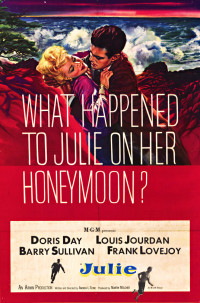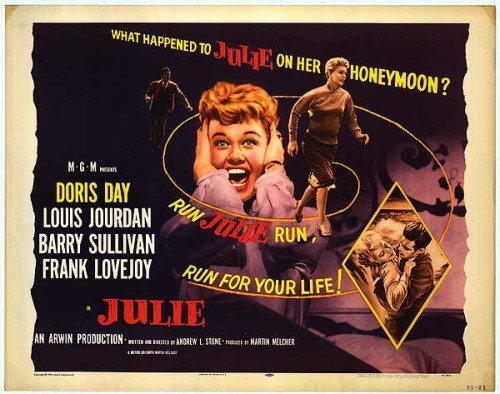What happened to Julie on her honeymoon? Run, Julie, run! Run for your life!
In the late 1950’s, Doris Day, America’s singing sweetheart, branched out from the romantic comedy genre with a handful of thrillers such as The Man Who Knew Too Much (1956), Midnight Lace (1960) and the damsel-in-distress film Julie (1956), a laugh out loud, high-flying, bad movie classic.
What it’s all about: Julie begins as most Doris Day movies do, with a sappy title song sung by its star. Amazingly, the theme from Julie received an Academy Award nomination.
The first clue that this isn’t your average Doris Day picture is that the film is in back and white. It’s oddly disconcerting to see Day in anything less than vibrant Technicolor. Perhaps black and white was chosen to give the movie more atmosphere, if so, it didn’t work.
We find Day, as the title character Julie Benton, in the middle of an argument with her husband Lyle, played by Louis Jourdan. She gets behind the wheel of her convertible and berates him for his jealous outburst at their Pebble Beach country club.
“It’s unforgivable,” she scolds as she twists the steering wheel back and fourth, never once coming close to matching the moving scenery projected on the screen behind her. Suddenly, Lyle presses his foot down on the gas pedal, sending them on a wild and dangerous drive along the picturesque Monterey coastline. Julie tries desperately to control the car as they speed faster and faster, screeching along hairpin turns. Lyle finally brings the car to a stop and Julie runs for it, collapsing at a picture perfect spot overlooking the sea.
“I’m so sorry,” he begs, “So desperately sorry. Help me fight this thing. I was jealous, jealous, blindly jealous.”
“He nearly killed us both,” Day needlessly reiterates in a breathy voiceover, “He seemed so sorry, so desperately sorry.”
Later, in front of the fireplace of their beachfront home, they discuss the mysterious circumstances surrounding the suicide of Julie’s first husband. Lyle cannot stand to have any man, dead or alive, in Julie’s life. “I had to have more answers,” Day whispers.
The next day at the country club, she meets with Cliff (Barry Sullivan) her former brother-in-law. “Julie, did it ever occur to you that Bob’s neck could’ve been placed in that rope after he’d been strangled… by a murderer? Lyle was there that night wasn’t he?”
This presents poor Julie with a classic bad movie conundrum. Does he want to kiss me, or kill me?
Later, as Lyle tickles the ivories, Julie tells us that, “I’d listen by the hour to Lyle practicing.” Never mind the fact that we can clearly see she’s lying on the couch listening to her husband play. The constant voiceover narration in Julie is so wildly unnecessary that it borders on parody.
“But today there was something strangely disturbing about his music, a sort of savage fury that was almost frightening. Gradually, as I listened to him play,” she drones on, “I began evolving a plan.”
And what is her grand scheme?
“If Bob hadn’t died,” she asks in bed that night, “What would you have done? Would you have done it… killed him?”
Lyle admits to the crime. “I had to lie there in his arms, lie there in panic and wait for morning to come,” she tells us as waves crash meaningfully outside their bedroom window.
Come morning, she sends Lyle on an errand next door. Once again, though we can clearly see everything that she’s doing, Julie gives us a ridiculous play-by-play account of her desperate grab at freedom. Any normal person would simply make a run for it. Not our Julie. Though her window of opportunity is slim at best, she still takes the time to carefully pack the perfect traveling outfit and collect her make-up and toiletries from the bathroom counter.
“I had the urge to get out of that house and get out of it fast!”
Julie, perhaps a little less talk and a little more running for your life.
Lyle may be a murderous loony, but he’s no dummy. He removes a spark plug from her car, making escape by vehicle impossible. So, Julie must hitch a ride into town. She tries to call Cliff, but can see from the phone booth that Lyle has followed her. Julie evades him and makes her way to the Monterey police station. “Sergeant, I want to report a murder,” she cries.
Since her former husband’s case has been closed and she has no tangible proof of Lyle’s duplicitous nature, the police have very little to work with. When Lyle is questioned he denies everything. It’s a frustrating case of he said, she said and there is nothing the police can do. With Cliffs help, Julie checks into a San Francisco hotel under an assumed name.
It’s not long before she receives a telephone call in her room. “Julie. Julie, you’re going to die.”
“Lyle, you’re insane.”
The San Francisco PD can’t do much either, but they’re a touch more sensitive to Julie’s dilemma. “He admitted to killing my husband, he admits that he wants to kill me, and nobody can help me do anything,” she squeaks.
With two officers and Cliff standing guard, Julie tries to sleep, “I had the chilling sensation of being watched by Lyle. I could feel his presence. It was ominous. It was strangely disturbing.”
Julie is awakened in the night to the menacing notes of a tape recorder playing the same classical music that Lyle was rehearsing earlier. Desperate to remain free of Lyle’s psychotic clutches, Julie returns to her former profession as a flight attendant and stays with a fellow stewardess in her San Francisco apartment.
Meanwhile, Lyle follows Cliff home from work one night. At gunpoint, he forces Cliff to take him to Julie. Cliff leaps from the moving vehicle in a bold attempt to escape and protect Julie’s whereabouts. Lyle shoots Cliff, rummages through his pockets, and finds the address of the apartment where Julie is staying.
Though mortally wounded, Cliff stumbles to a farmhouse and finds help. He calls the police and they go to the apartment building to warn her. Julie is gone. She’s left for the airport, a last minute replacement on an outgoing commuter flight. Skulking in the shadows, Lyle watches Julie catch a cab to the airport terminal. He boards her flight and manages to keep his presence a secret by hiding his face behind a newspaper.
Midway through the flight, San Francisco homicide calls, worried that Lyle may have somehow learned of Julie’s location. The only way to know if he’s on board is for Julie to identify him. “Be casual,” the captain tells her, “everything depends on it.” She makes her way to the back of the cabin and then works her way forward, trying to remain inconspicuous and identify Lyle from behind. Sure enough, she recognizes the back of his brylcreamed head.
Considering that Julie wouldn’t shut up for the first half of the movie, this would seem to be a perfect moment for yet another long-winded dramatic voiceover, but now she’s inexplicably silent. As Julie makes a mad dash to the front of the plane, Lyle gains access to the cockpit. Unbelievably, a Wild West shootout ensues. The pilot is killed and Lyle is wounded. “I promised you it wouldn’t be easy,” he tells her, “You are going to be in this airplane, high in the air, with nobody to fly it.” With his dying breath he shoots the co-pilot.
A doctor on board proclaims the injury to be life threatening. There is only one person who can fly the plane. Guess who?
The co-pilot turns the plane around in hopes that the radio tower in San Francisco will be able to talk the plane down with Julie at the controls. He gives her a few pointers before passing out. On the ground, the macho guys at flight control give Julie instructions while constantly referring to her as “Honey.”
“I’m terrified,” she tells ground control as she brings the plane into its approach pattern. While wringing all the pathos she can out of the melodramatic scenario, she banks the plane left and then right with all the finesse of the driving skills she demonstrated earlier in the movie. Julie finally touches down… with her eyes closed!
With the plane safely on the ground, a look of relief passes over our heroines face. The orchestra swells and the screen fades to black. Not only has she saved herself and the passengers, but she has paved the way for heroic flight attendants in future bad movies about disaster-prone airliners.
In conclusion: The drama for the character she played on screen was no match for what Doris Day had to endure behind the scenes of Julie. In the book, Doris Day: Her Own Story, she admits that wasn’t particularly interested in making Julie. Both her previous husbands had been jealous of her success, so it’s easy to understand why Day would be reluctant to play a woman victimized by her husband’s psychotic jealousy. Day’s husband Martin Melcher, who also produced the picture, was finally able to talk her into taking the role.
During filming, Day experienced severe abdominal pain. Her husband insisted that she follow her Christian Science faith, forgo seeing a doctor, and adhere to the films strict shooting schedule. After the movie was completed, Day sought medical attention and found that she needed major surgery to remove an endometriotic tumor.
Despite all the turmoil, Day enjoyed shooting on location in Carmel so much that she later made the California coastal community her home.
At a time when most movies were still made on studio backlots and soundstages, the extensive use of location filming during Julie set it apart from other films of the time. Though real locations added authenticity to a film, studio sets were still considered easier to light and control. This may explain why shadows from the boom mike and camera crew can be seen in nearly every scene of the film.
Julie has all the ingredients necessary for a guaranteed bad movie classic. Take one part Sleeping with the Enemy (1991) and one part Airport 1975 (1974), add America’s sweetheart and you’ve got an overwrought, low-budget, woman-in-peril thriller that will satisfy any fan of cool cinema trash.



